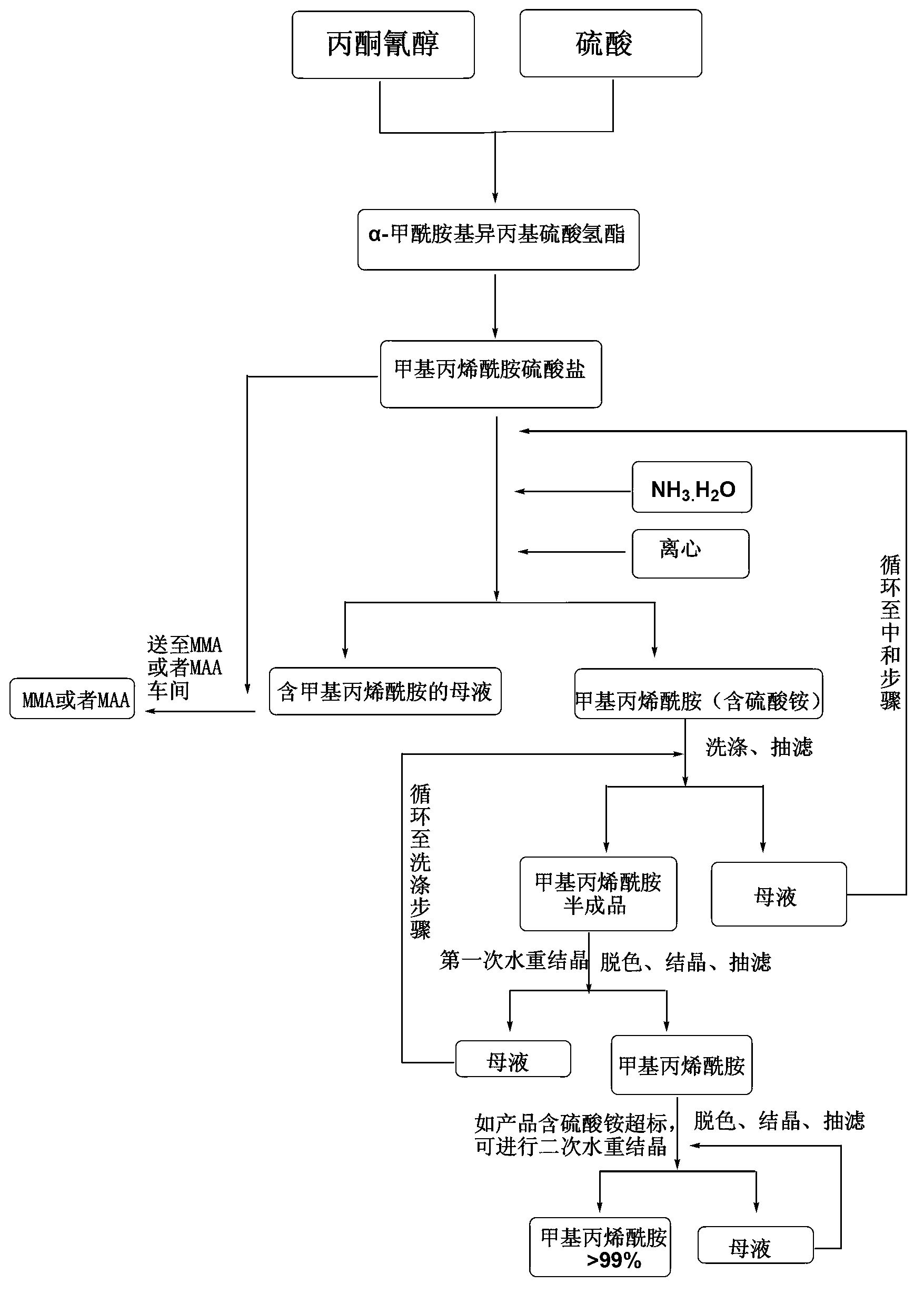Method for joint production of methacrylamide, methyl methacrylate and methacrylic acid
A technology of methyl methacrylate and methacrylamide, applied in the field of methacrylamide, which can solve the problems of difficulty in recycling ammonium sulfate, product loss, and environmental pollution caused by waste liquid discharge, so as to reduce emissions and increase productivity , Environmentally friendly effect
- Summary
- Abstract
- Description
- Claims
- Application Information
AI Technical Summary
Problems solved by technology
Method used
Image
Examples
Embodiment 1
[0029] 1) Put concentrated sulfuric acid (1368 kg) and acetone cyanohydrin (850 kg) through the rotameter and put them into the reaction kettle at a ratio of 1.6:1 (mass ratio). Acetone cyanohydrin reacts with concentrated sulfuric acid and hydrolyzes to form α-formamide Base isopropyl hydrosulfate, because the reaction at this time is an exothermic reaction, so the cooling system is turned on to keep the reaction temperature in the pot at 90°C, and the product overflows from the overflow of the reactor and enters the tubular reactor;
[0030] 2) The above reactants continue to react with concentrated sulfuric acid in the tubular reactor, and α-formamidoisopropyl hydrogen sulfate is dehydrated under the action of concentrated sulfuric acid to form methacrylamide sulfate. This reaction is endothermic Reaction, heated to 130°C with steam, because the temperature is too low, the chemical reaction is incomplete, and the temperature is too high, it is easy to cause polymerization or...
Embodiment 2
[0039] 1) Put concentrated sulfuric acid (1368 kg) and acetone cyanohydrin (850 kg) through the rotameter and put them into the reaction kettle at a ratio of 1.6:1 (mass ratio). Acetone cyanohydrin reacts with concentrated sulfuric acid and hydrolyzes to form α-formamide Base isopropyl hydrosulfate, because the reaction at this time is an exothermic reaction, so the cooling system is turned on to keep the reaction temperature in the pot at 90°C, and the product overflows from the overflow of the reactor and enters the tubular reactor;
[0040] 2) The above reactants continue to react with concentrated sulfuric acid in the tubular reactor, and α-formamidoisopropyl hydrogen sulfate is dehydrated under the action of concentrated sulfuric acid to form methacrylamide sulfate. This reaction is endothermic Reaction, heated to 130°C with steam, because the temperature is too low, the chemical reaction is incomplete, and the temperature is too high, it is easy to cause polymerization or...
Embodiment 3
[0049] 1) Put concentrated sulfuric acid (1368 kg) and acetone cyanohydrin (850 kg) through the rotameter and put them into the reaction kettle at a ratio of 1.6:1 (mass ratio). Acetone cyanohydrin reacts with concentrated sulfuric acid and hydrolyzes to form α-formamide Base isopropyl hydrosulfate, because the reaction at this time is an exothermic reaction, so the cooling system is turned on to keep the reaction temperature in the pot at 90°C, and the product overflows from the overflow of the reactor and enters the tubular reactor;
[0050] 2) The above reactants continue to react with concentrated sulfuric acid in the tubular reactor, and α-formamidoisopropyl hydrogen sulfate is dehydrated under the action of concentrated sulfuric acid to form methacrylamide sulfate. This reaction is endothermic Reaction, heated to 130°C with steam, because the temperature is too low, the chemical reaction is incomplete, and the temperature is too high, it is easy to cause polymerization or...
PUM
 Login to View More
Login to View More Abstract
Description
Claims
Application Information
 Login to View More
Login to View More - R&D
- Intellectual Property
- Life Sciences
- Materials
- Tech Scout
- Unparalleled Data Quality
- Higher Quality Content
- 60% Fewer Hallucinations
Browse by: Latest US Patents, China's latest patents, Technical Efficacy Thesaurus, Application Domain, Technology Topic, Popular Technical Reports.
© 2025 PatSnap. All rights reserved.Legal|Privacy policy|Modern Slavery Act Transparency Statement|Sitemap|About US| Contact US: help@patsnap.com

